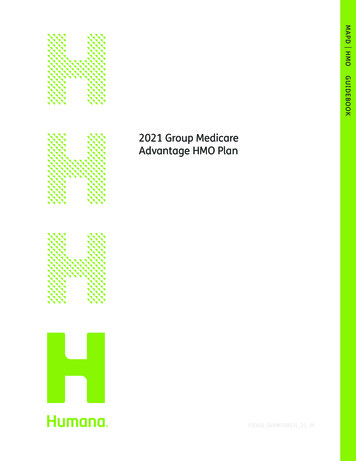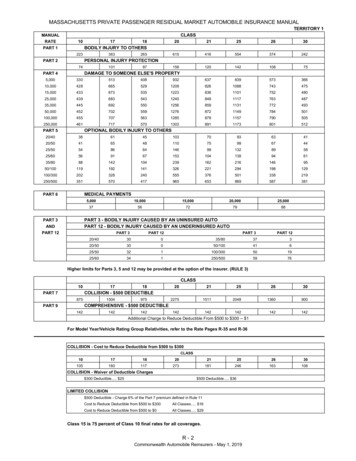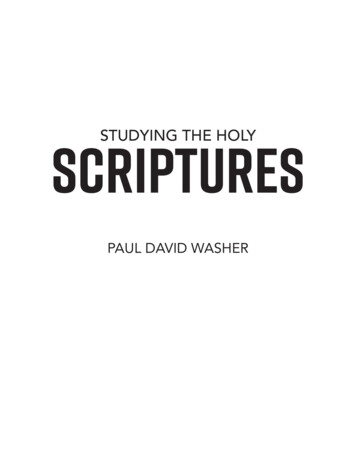
Transcription
Part OneContinuitiesNUP-Altieri-Nace text.indd 275/26/17 9:01 AM
NUP-Altieri-Nace text.indd 285/26/17 9:01 AM
Srikanth Reddyfrom VoyagerThe world is the world.To deny it is to break with reason.Nevertheless it would be reasonable to question the affair.The speaker studies the world to determine the extent of his troubles.He studies the night overhead.He says therefore.He says venerable art.To believe in the world, a person has to quiet thinking.The dead do not cease in the grave.The world is water falling on a stone.NUP-Altieri-Nace text.indd 295/26/17 9:01 AM
NUP-Altieri-Nace text.indd 305/26/17 9:01 AM
Chapter 1Voice and Erasure in Srikanth Reddy’s VoyagerLangdon HammerThis haunting series of assertions appears on the first page of Srikanth Reddy’s long poem Voyager (2011).1 The haunting effect has to do partly withthe way each claim stands on a line of its own, emerging from and then echoing in the space that surrounds it. It also has to do with the fact that Reddy’spoetry really is haunted: every word of Voyager has been taken from KurtWaldheim’s memoir of his career as Secretary General of the United Nations,In the Eye of the Storm (1985). “The dead do not cease in their grave” indeed.To be clear: what Reddy is doing is not what modernist poets like Poundor Moore or Eliot do when they sample sources. Their borrowings most ofteninvolve a complete syntactic unit, a phrase or a sentence or more; the quotedspeech is marked as such; and it’s set inside the language of the poem quotingit, with the result that the distinction between the two texts, the one quotedfrom and the one doing the quoting, is more or less preserved. Here Reddytakes apart his source text bit by bit, at times isolating lexical units as smallas a preposition or an article, to build new statements altogether—and all ofhis words come from Waldheim. The voice is therefore a weird composite, thetriangulated expression of two authors that belongs to neither one precisely.In this way Voyager presents a novel and I think distinctly contemporary instance of poetic difficulty. These opening lines require a reader to askthat basic discussion-starting question posed by the New Criticism: Who isspeaking? But it is not a question that can be settled: even here, although farmore troublesome passages await us in the poem, it could be asked of everysentence. And behind it, I’ll suggest, are a number of other, rather odd questions: What is it like to be the speaker of a poem, or at least the speaker of apoem such as this? How does it feel when the central feeling expressed is anabsence or (better) a dislocation of feeling? And along with these come questions about other sorts of coherence: How does one sentence (or how doesone word or phrase) follow from another? What is the operative logic in agiven sequence? What do Reddy’s lines add up to? Later I will work throughanswers to these questions by looking carefully at the lines quoted above. But31NUP-Altieri-Nace text.indd 315/26/17 9:01 AM
32Langdon Hammerthe results will be of primarily local use because Voyager resists stable resolution as we move from one page to the next.The difficulty of deciding who is speaking in Voyager is further compounded by the fact that each of its three main sections, or “books,” exploresa distinct genre and formal plan. How the whole poem fits together is anotherdifficulty, then, and a major one. Voyager is not a poem with a beginning,middle, and end, but a poem that begins and ends three times. Each iterationamounts to a particular event, a new reading, if you like, of In the Eye of theStorm. Which means that we must approach the poem as simultaneously anact of writing and an act of reading.The poem’s technique, usually called “erasure,” is described quite explicitly in Book 2. “I began to cross out words from his book on world peace”(23), Reddy writes, referring to Waldheim and In the Eye of the Storm. Thenhe says again: “I had to cross out his world anew. This history is the effect ofthat curious process” (25). The process of “crossing out” Waldheim’s book isrepresented graphically elsewhere in Voyager when Reddy includes a bit ofcrossed-out text. In the poem’s epilogues (there are three, one for each bookand the erasure that created it), crossing out takes over: here Reddy prints theepilogue to Waldheim’s memoir three times, striking through line after lineof text, leaving only a few scattered words for readers to assemble in newsentences. A number of paratextual references call attention to the technique:Reddy mentions his erasure of Waldheim’s text in his acknowledgments; ablurb from Marjorie Perloff calls attention to Waldheim and the erasure technique on the back cover. Moreover, the method can be studied on a websiteto which the acknowledgments direct us, where Reddy has posted examplesof his writing process.2I’ll say more about the method and its implications shortly. What is Reddydoing when he applies it to In the Eye of the Storm? With its notorious falsification of Waldheim’s service as a Nazi SS officer who was in a position tobe aware of, if not more directly involved in, war crimes committed by theGerman military in Greece and Yugoslavia, the memoir is not a promisingstarting place. There can be little point in arraigning Waldheim and exposinghis self-representations as lies: that’s been done, and by scholars and journalists better equipped to do it than a poet.3 But Waldheim’s culpability isnot the essential issue in Voyager. Rather, in Reddy’s poem Waldheim comesto stand for a general failure of humanistic ideals and democratic leadership, stretching beyond National Socialism and the Second World War to thedemocratic regimes that dominate the world today.Or, because Reddy’s engagement is specifically with Waldheim’s language,it would be more accurate to say: Waldheim comes to stand for a failed way ofspeaking. Using Waldheim’s words, as he does everywhere in Voyager, Reddysums up the case with irony and sympathy too: “This man, legend states,likely knew of the mass execution of groups of people as a capable officerrequired to collect and analyze data, prepare reports, conduct investigations,NUP-Altieri-Nace text.indd 325/26/17 9:01 AM
Voice and Erasure in Srikanth Reddy’s Voyager33and otherwise facilitate operational projects in the last world war. At thetime, however, he did not express concern at this action. To a degree this isunderstandable. His voice failed” (21).That failure of voice is complex. It involves two stages of denial and twosilences, the second repeating while also covering up the first, as, over thedecades, Waldheim first failed to speak against the “mass execution of groupsof people” going on around him and then failed to speak of that wartimefailure of protest. Moreover, Waldheim’s failure was never a matter of sayingnothing. Both silences were disguised by the fluent speech of a bureaucrat:“a capable officer” collecting and analyzing data, and then an internationalstatesman recalling his actions on the world stage. Those roles and the discourses proper to them, no matter how distant from each other in style andfunction, are joined in the moral history of one man’s voice.Engaging with that history, Reddy tries to get inside Waldheim’s voice, toanatomize, appropriate, and reformat it, and ultimately to rescue somethingfrom its ruins. Reddy seems interested specifically in the irony that this manwhose voice conspicuously “failed” during the Second World War shouldhave become a general “spokesman for humanity” in the postwar era. Therole is epitomized by the message from Waldheim carried aboard the Voyagerinterstellar space probes launched by NASA in 1977. Speaking as the Secretary General of the United Nations, Waldheim offers “greetings on behalf ofthe people of our planet”: “We step out of our solar system into the universeseeking only peace and friendship, to teach if we are called upon, to be taughtif we are fortunate. We know full well that our planet and all its inhabitantsare but a small part of this immense universe that surrounds us and it is withhumility and hope that we take this step.”4The human collective unmarked by difference that Waldheim speaks forin this laughably vacuous message is as much a fantasy as the alien being headdresses. But Reddy takes his poem’s title from the Voyager mission, and tothat extent, he takes it very seriously (perhaps the poem is a machine bearing its record of life on earth into uncharted space?). Nor is Reddy ridiculingWaldheim when he describes him as “a man who by some quirk of fate hadbecome a spokesman for humanity, who could give voice to all the nationsand peoples of the world, and so to speak, the conscience of mankind.” Waldheim’s role as a spokesman for “all nations and peoples” descends from anEnlightenment ideal that is as much poetic as political. It is memorably articulated by Wordsworth: “In spite of difference of soil and climate, of languageand manners, of laws and customs: in spite of things silently gone out ofmind, and things violently destroyed; the Poet binds together by passion andknowledge the vast empire of human society, as it is spread over the wholeearth, and over all time.”5There is no mention of Wordsworth in Voyager. But I think Reddy’s poemasks by implication whether a vision of poetry such as this can be recovered and refashioned for our time—in spite of the global history of politicalNUP-Altieri-Nace text.indd 335/26/17 9:01 AM
34Langdon Hammeroppression, torture, and genocide, “in spite of things gone silently out ofmind, and things violently destroyed,” which is the repressed subtext of Waldheim’s memoir. Reddy grasps In the Eye of the Storm as a grotesquely failedpoem from which he will attempt to create a new and truer one. Humanity,he seems to say, goes on needing people who will try to speak for it.Reddy’s ambivalent attitude toward Waldheim as spokesman has a parallelin the complex effects of his erasure technique, although the point of thattechnique appears simple enough on the face of it. The idea of a representative speaker implies in poetry a first-person lyric voice valued for originalityand authenticity, invention and sincerity. (Again Wordsworth is a model.)The constraint Reddy works with throughout Voyager—his choice to useonly Waldheim’s words and maintain the order in which they appear in thememoir—flies in the face of that idea: here is a long poem made entirely ofsomeone else’s language.Erasure literalizes, and so brings inescapably to mind, the truism thatbooks are made out of other books. Precedents include the “treated” booksof Marcel Bloodthaers, who blacked out the words of Mallarmé’s Un coupde dés (1969), highlighting the poem’s spatial arrangement, and Tom Phillips, whose work in progress, A Humament (begun in 1966), is made out ofan obscure nineteenth-century novel. Ronald Johnson’s visionary redactionof Paradise Lost, Radi os (1976, reprinted in 2005), and Jen Bervins’s NETS(2004), based on Shakespeare’s Sonnets, are other examples. Once an eccentric strategy, erasure has become a familiar practice, as inviting to intellectualyounger poets as the sestina was thirty years ago. Along with other types offound text, it is a period-defining technique for an era when the conventionsof lyric autobiography have been challenged by the antiexpressive, citational,procedural writing endorsed in Marjorie Perloff’s Unoriginal Genius: Poetryby Other Means in the New Century (2010).In particular, Voyager shares a good deal with the “uncreative writing”on exhibit in Craig Dworkin and Kenneth Goldsmith’s Against Expression:An Anthology of Conceptual Writing (2011). But in Reddy, as opposed toconceptual writers like Dworkin and Goldsmith, the rejection of a Romantic, expressive poetics is not at all complete or programmatic. He is curious,rather, as to how erasure, this technique so associated with today’s critiqueof poetic voice and its allied values, once it is put to work on a manifestly“failed” voice, might generate a voice (or voices) with new expressive properties. So although Reddy himself uses it “for lack of a better word,” the termerasure hardly captures what he is doing.6 It implies silencing a voice ratherthan appropriating and reanimating it, and it calls to mind negation andaggression rather than collaboration (Reddy has said he feels “profoundlyindebted to Waldheim as a literary collaborator”).7To be sure, negation and aggression are part of the approach. This isemphatically so when Reddy draws a line through Waldheim’s words in hisNUP-Altieri-Nace text.indd 345/26/17 9:01 AM
Voice and Erasure in Srikanth Reddy’s Voyager35Figure 1.1. Worksheet from stage 1 in Reddy’s erasure process (tiny.cc/voyagermethod).Note that Reddy ignores the chapter break in Waldheim’s memoir as a unit oforganization for his poem.three epilogues. Those nine canceled pages highlight the defacement of textthat underlies Reddy’s process throughout the poem. Yet there’s more to thatprocess. On his Voyager website, Reddy divides the work of composition intothree steps and gives samples of each. First, he marked up the text of In theEye of the Storm, circling and underlining words and phrases (fig. 1.1). (Heworked not on a bound copy of the book but on photocopies: it was alwaysthe text, rather than the physical object, that he was concerned with. Thisfocus distinguishes his project from, among other practices, book art.) Then,in the process of selecting words, he “deleted language from the book, like agovernment censor blacking out words in a letter from an internal dissident,”as he puts it on the website (fig. 1.2). This is the moment of “erasure” proper.Finally, he closed the space between selected words to create new syntacticand grammatical structures, introduced punctuation, and made choices offormat and prosody, integrating what he had preserved of the memoir in atext of his own making. So the process included acts of cancellation, preservation, and reconfiguration.8NUP-Altieri-Nace text.indd 355/26/17 9:01 AM
36Langdon HammerFigure 1.2. Worksheet from stage 2 (tiny.cc/voyagermethod). The sentence “Thishistory is the effect of that curious process” follows “I had to cross out his worldanew” in Voyager, Book Two (25).On the one hand, this is a highly constrained, rule-driven means of writing poetry, binding the poet’s choice of words to a specific external lexicon.On the other hand, the freedom Reddy permits himself is notable. After all,the lexicon he draws on is a 268-page book. And while he confines himselfto Waldheim’s words and the order in which he finds them, he crosses out asmany pages as he likes before selecting the next word or phrase; he changesthe grammatical function of words and phrases when he wishes; and he freelycreates his own rhythms and images, inventing personages, place names, anda great deal more. The poem is not an attempt to write poetry “for” Waldheim as if it were some kind of dramatic monologue; there is never an issue ofverisimilitude. From this perspective, Reddy’s method looks less like a refusalof “originality” than a peculiarly elaborate means of achieving it.Guiding each erasure, as I’ve said, were decisions about the genre andprosody Reddy would employ. In Book 1, he daringly eliminates the grammatical basis of Waldheim’s memoir—the first-person pronoun—to createa different sort of text entirely, made up of sequences of impersonal prosestatements, ten to a page. The question seems to be, can Waldheim’s text,despite itself, be made to yield a philosophy, an impersonal discourse of truthNUP-Altieri-Nace text.indd 365/26/17 9:01 AM
Voice and Erasure in Srikanth Reddy’s Voyager37we can apply to the ongoing violence of our world? Reddy’s model is thepropositional structure of a text like Wittgenstein’s Tractatus, to the famousfirst sentence of which (“The world is everything that is the case”) the startof Voyager alludes: “The world is the world.” Wittgenstein’s reasoning, however, is parodied more than emulated in the statements that follow, whichinvolve a critique of the official rationality embedded in Waldheim’s proseand perhaps a critique of rationality as such, viewed as the will to order theworld intellectually. Let’s look back now at those opening lines to examinethat critique and the interpretive difficulties it entails: Who is speaking? Howdoes one claim follow from another?The initial tautology does not at first seem like the start of any train ofthought. It expresses a simple, seemingly irrefutable realism, a rationalitybased on common sense: the world is the world we all know, QED. Butthe poem immediately throws that idea into question. Though presented asanother statement of fact, the second sentence’s abrupt defense of the firstmakes it feel like a warning: if we deny that the world is the world andclaim that it is merely “a” world, implying that other worlds, or at leastother accounts of this one, are possible, we will violate the rules of legitimatethought and be judged out of bounds, beyond reason. The second sentencenow makes the first appear less simple and assured and more like an attemptto forestall objections that we didn’t know had been raised but are alreadypresent by implication, motivating the poem to start with. What counts as“reason” seems brittle and easily disturbed: an official picture of the real,held in place by rhetorical force.As if to acknowledge that weakness, the third sentence allows that ourdefinition of what is “reasonable” must be stretched far enough “to question the affair.” That’s a significant adjustment: rather than reason in theabstract, Reddy has introduced the pragmatic category of the reasonable, amatter of social consensus more than logic or principle. There is a modulation in diction too audible in the puffed-up assertiveness of “nevertheless,”the hedging, stilted elegance of the conditional (“it would be”), the vaguenessand euphemism of “to question the affair.” The last word resonates becausethe controversy precipitated by In the Eye of the Storm is known as “theWaldheim affair.” Here, as so often in Voyager, Reddy precisely catches thetone of official muddle and obfuscation. This is highly self-conscious speech,attempting to manage the impression it makes through carefully counterbalanced weights and measures, the cumulative effect of which is to say nothingconcrete, nothing particular, and in that respect, nothing at all.It’s tempting to identify the speaker “who studies the world to determinethe extent of his troubles” as Waldheim himself, emerging as a character in thepoem. But “the speaker” is pointedly unspecific. He is a rückenfigur whom weencounter as an outline without face or identity, engaged in meditation on theworld, possibly of the sort the poem itself is engaged in, as if Reddy had takena step back to show us the person speaking the poem’s opening lines. ThatNUP-Altieri-Nace text.indd 375/26/17 9:01 AM
38Langdon Hammerterm—the speaker—neatly holds together political and poetic models of representation: we use it to indicate the leader of a democratic assembly and thevoice in a poem. Both operate by means of convention and formal arrangement; and both are suspect as frayed, if not failed, ideals, masking particularbiases and interests behind the claim to representativeness. To reassert hisauthority in the face of these “troubles,” the speaker appeals to logic (“therefore”) and the traditions of high culture (“venerable art”). But the repetitionof “he says” makes his discourse seem like a matter of rote, without specificcontent or point. That the speaker is male is important and not a surprise.Having moved over the space of a few lines from propositional reasoningto description of a man thinking, Reddy suddenly reverts to a proposition:“To believe in the world”—to be able to say, “The world is the world” withsimple confidence—“one has to quiet thinking.” “Reason,” as we suspected,turns out to require the suppression of thinking. But why does thinkingthreaten our belief in the world? Reddy answers the implied question bymentioning the dead who “do not cease in the grave.” To think is to enterinto the silences in the historical record and there, as in a burial ground,to encounter the “disappeared” and “silent,” all the people murdered in thewars that have shaped the map of nations, our picture of the world as it is.9“The dead do not cease” because, precisely in their silence, they clamor forexpression and recognition.Their restless condition is refigured when this series of statements ends byrevising the first. The world is not the world; it is “water falling on a stone.”Instead of tautology, we have a metaphor. It implies that the world is nota noun but a participle, not a static fact but an ongoing event. A collisionof opposites, unstoppable and ungraspable, it is not to be accounted for byrational propositions moving in series toward a conclusion, in the form of aproof. To represent it truly, a text would have to be more like an explosion,or a fire.The page of poetry I’ve just been describing is like a debate within a mind,or between two minds, or perhaps within a discourse attached to no mind inparticular that is pushed forward, forced this way and that, by the pressureof facts that threaten its claim to reason and mastery, as Reddy deconstructsthe rationality of Waldheim’s writing to see what thoughts it represses andwhat other ways of thinking it might make available. That deconstructionworks by disassembling sentences and assembling new ones from the scattered parts. Its halting, probing rhythms are a record of Reddy’s experience asa reader of Waldheim’s memoir, and they reproduce a version of that experience for his reader.Erasure, Reddy has commented, “became like a form of reading, or detection. Which made me feel . . . that writing is itself a form of reading” (“TheWeight of What’s Left [Out]”). To examine his compositional process on hiswebsite is indeed to observe someone reading—or perhaps learning to read?NUP-Altieri-Nace text.indd 385/26/17 9:01 AM
Voice and Erasure in Srikanth Reddy’s Voyager39That is, as he marks up his source text, pointing up parts of speech, attendingless obviously to “content” than to grammar and syntax, circling or underlining words and phrases to return to, Reddy behaves like the student of aforeign language, diagramming a text to absorb what he can for practical use.The interesting turn is that the foreign language Reddy uses the memoir tolearn is English. Importantly, In the Eye of the Storm is an English-languagework, not a translation of Waldheim’s native German.10 Only that’s not precise enough: what Reddy is trying to “learn” is no one’s native tongue. Onlyacquired through long training and acculturation, it is the contemporary language of power, of bureaucracy and business, the idiom of expert rationalityfamiliar to us from press conferences, policy statements, media interviews,and the like. This is a variety of English as exchangeable and placeless as thearchitecture of corporate offices and airport hotels; it aspires to the prestigeand authority of universal reference that any merely national language bydefinition lacks.The special contemporaneity of Reddy’s poem and much of the difficulty itinvolves reflect his engagement, through Waldheim’s memoir, with a specificpostwar phenomenon: the rise of English as the default public discourse ofglobal elites. What are the qualities of that discourse? Franco Moretti andDominique Pestre have tracked the evolution of one variant—which, echoingOrwell’s 1984, they call “Bankspeak”—by undertaking a quantitative linguistic analysis of the World Bank’s annual reports since 1950.11 What theydescribe is suggestive though scarcely surprising: from the 1970s onward, thelanguage of the World Bank’s reports has grown increasingly abstract. Thisdevelopment is reflected in, among other features, the proliferation of nominalizations—nouns, usually Latinate ones, made out of verbs. Absorbingand obscuring the actions they refer to, the nominalizatons in these reportstend to blur reference to concrete political and economic realities, and makehuman subjects disappear. Along with this abstraction comes an indeterminacy of time and place that Moretti and Pestre demonstrate also on the levelsof grammar and rhetoric.Their research seeks to get inside the linguistic operations of the “management discourse” that dominates the world economy (in which the nounmanagement is among the most frequently used) to call attention to its construction and analyze its repressed logic, in more or less the same way thatOrwell, insisting on the concrete effects of state policy and war, approachespolitical and military propaganda in “Politics and the English Language.”With pen and ink rather than computers and graphs, Reddy does somethingsimilar to In the Eye of the Storm. But the World Bank’s annual report is notthe same thing as a statesman’s memoir. As opposed to Moretti and Pestre,Reddy is concerned with a literary question: How does a bureaucratic discourse affect the one who inhabits it? Is it possible, and if so what is it like, toexperience the world subjectively in language that turns human subjects intoabstractions and makes them disappear?NUP-Altieri-Nace text.indd 395/26/17 9:01 AM
40Langdon HammerThese questions emerge forcefully in Book 2 of Voyager. In Book 1, Reddy’s daring move was to remove Waldheim’s first person. In Book 2, daringnow in an entirely different way, Reddy restores Waldheim’s “I” and uses it tospeak about his own experience, according to the conventions of autobiography. In blocks of prose, one to the page, Book 2 offers lyric introspection of atype found in a private journal or memoir. The nature of the world—and ofworld-making—is in question again, but this time the point of view is highlypersonal. For instance: “As a child, spelling out world was to open a world inmyself, private and byzantine, with mountains by a pale, fragile sea, the coaststretching southwards in the curtained evening hours” (23). Or again: “In myoffice a globe was set up, less a world than a history of imperialism and corruption. I used to search that poor political patchwork in the period leadingup to my tenure” (25). Reddy’s use of In the Eye of the Storm to describe (orseem to describe) the inner world of his childhood or his daily life “in theperiod leading up to my tenure” is a remarkable feat. But it’s not a naturalistic illusion he is going for. Rather, his prose is calculatedly impersonal (the useof the passive voice in “was to open” or “was set up”), not at all colloquial(“private and byzantine,” “pale, fragile sea,” “the curtained evening hours”),and subtly fragmentary in grammar (the intransitive use of search). Theseeffects keep reminding us that Reddy’s sentences are made out of quotationand echo with the odd formality of their source.They also underline a certain stitched-together quality in Waldheim’s writing that is easy to overlook, given its smooth contours and appearance ofrational control. Yet, on inspection, Waldheim’s not-quite-idiomatic idiomsgive his style the feeling of an acquired language, meticulously spoken. Theforeword to In the Eye of the Storm begins this way:This is not a book of memoirs in the ordinary sense, nor is it a comprehensive account of events during my term of office as SecretaryGeneral of the United Nations. Had I embarked upon either task, itwould have taken me far beyond the confines of this present endeavor.Instead I have attempted to offer some insight into my background, actions, and aspirations. Without dwelling upon the routineand frustrations that are also the hallmarks of any arduous career,I have described those events and episodes which I feel bear somesignificance for the course of history. (In the Eye of the Storm, vii)There is perfect confidence in this writing; nothing ruffles its surface. Yetphrases like “had I embarked upon either task,” “far beyond the confinesof this present endeavor,” or “the hallmarks of any arduous career” feel asthough they have been cut out of a thesaurus and taped in, one after another.Put that diction together with the studied casualness of “offer some insightinto” and the self-regarding modesty of “bear some significance for theNUP-Altieri-Nace text.indd 405/26/17 9:01 AM
Voice and Erasure in Srikanth Reddy’s Voyager41course of history,” noting the strategic vagueness of both phrases,12 as wellas the fact that the author’s feelings, if not missing, are prim and disciplined,and you have a good sense of Waldheim’s prose style throughout In the Eyeof the Storm.Probably the style interests Reddy because Waldheim’s voice, unlike Milton’s or Shakespeare’s (the canonical poetic sources for Ronald Johnson’sand Jen Bervins’s erasures), is a mode of official expression, not simply prosaic or subliterary but generic. The sound of a person comes through, but itis the sound of a person struggling to make himself present—and to concealhimself too; a person struggling to sound statesmanlike and intimate, tryingto project personality in a formal idiom that is a little too weighty, a littleinexact, and in those ways not fully controlled, despite the effort to controlit. The style is the product of a patient, incomplete effort to construct aplausible speaker. Reddy makes the point concisely in Book 1: “He wroteformally in private” (13). Or better still: “Kurt Waldheim is a formal negotiation” (15).By adapting this style to describe his own experience, Reddy experimentswith a provocative overlay of perspectives. Already in Book 1 the ambiguous identity of “the speaker” had been a way to play with this idea. “Hehad a professorship at the university and had been out of contact with hispersonality as a result” (8), Reddy writes, and his readers who are universityprofessors can laugh—at the idea that being a professor puts one in danger oflosing touch with one’s personality and at Redd
the results will be of primarily local use because Voyager resists stable resolu-tion as we move from one page to the next. The difficulty of deciding who is speaking in Voyager is further com-pounded by the fact that each of its three main sections, or "books," explores a distinct genre and formal plan. How the whole poem fits together is .










